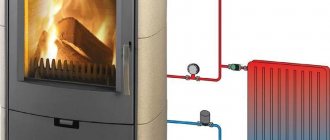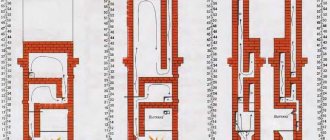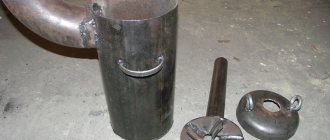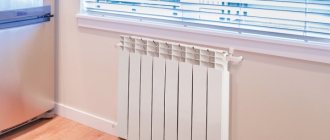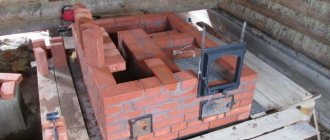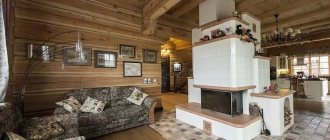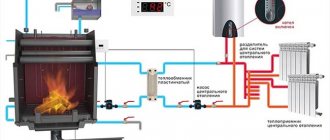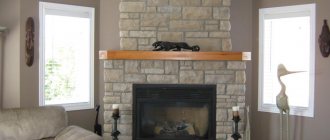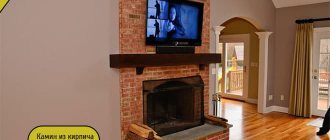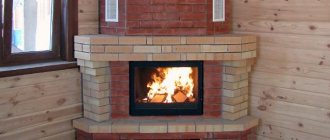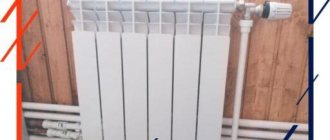A real fireplace is synonymous with comfort. There is nothing more pleasant than sitting in a rocking chair under a warm blanket on a winter evening, with a mug of hot tea or cocoa, and looking at the crackling logs behind the carved fireplace grate. But the fireplace also has a practical side - in addition to getting pleasure from contemplating the flames of the hearth, you can use the fireplace to heat the house as an additional source of heat. How to properly arrange a fireplace in a private home so that it not only pleases the owners with its appearance, but also effectively warms us, we will figure it out in this article.
Heating systems
To heat the premises, a main line is required. Pipes through which water will circulate are suitable for this role. There is an open and closed heating system.
In the first case, the movement of water is carried out due to the inclination of the pipes. Convection promotes circulation to the very top, then water flows into other rooms, the level decreases each time and the water returns through the return line.
In the second case, the movement of water occurs due to forced circulation, which occurs due to the pumps swinging.
How does it work
To fully appreciate the effectiveness of a fireplace with an air circuit, you will have to consider the principle of heat transfer in a classic fireplace. As you know, there are three ways to transfer thermal energy. The thermal conductivity of air is quite low, so this method has never been considered as the dominant one.
The advantages of convection had not previously been objectively assessed, so the key bet was placed on radiation. A classic fireplace with an open firebox did not even heat the air in the room, but the surrounding objects, and they, in turn, transferred heat to the air and the room warmed up. However, it was impossible to even dream of transferring heat to other rooms.
Over time, the transfer of matter, as a method of transporting energy, became more and more of interest to furnace masters. Modern air heating from a fireplace is based on the fact that heated air is distributed throughout the rooms. The design of such a fireplace accomplishes two main tasks:
- efficient heating of air masses;
- their transmission over a distance.
Scheme of operation of the air heating system
The first task is helped by hollow channels that are installed in the fireplace body between the firebox and the outer wall. They can be made in the form of a labyrinth in order to increase the area of contact of air with the heated walls of the firebox.
The Russian stove in the chimney area is constructed in a similar way. Only tap heat transfer occurs from hot air to the walls. The air from below enters the channels through special holes and heats up. Convection currents move upward and as they move, the air temperature rises even more. Natural convection alone is not enough to move air through winding channels. It is necessary to use fans that pump in new portions of air and displace the heated masses that provide heating to the room.
The second task is achieved by distributing the air duct throughout the rooms. Warm air flows through the ducts into neighboring rooms. If the length of the air duct does not exceed 3 meters, then natural convection is used for transportation. Otherwise, forced circulation is ensured.
Application area
Often fireplaces with the possibility of water heating are installed in dachas or country houses, that is, where people do not live, but occasionally come, as well as in places where it is impossible to install gas. In addition to its main purpose, the fireplace-stove can be used as an interior decoration.
Another advantage of this system is its small size. Fireplaces have massive walls that heat up well and maintain a warm temperature in the room for a long time.
Tips for choosing a fireplace
The most reliable option for a summer residence is considered to be a fireplace stove made of cast iron. This material is highly durable, durable, and retains heat well. Cast iron models look gorgeous. When logs crackle in such a stove, you want to relax and enjoy your vacation. A more budget option is steel models. Such devices “capture” summer residents with their light weight and attractive appearance. Steel models heat up quickly and cool down just as quickly, which is a big plus for some people.
The fireplace stove not only gives warmth to people, but also decorates the interior. Choose a model that fits perfectly into the design of your country house. If the room is small, then choose a corner option that will not take up much space. Wall-mounted models, as the name implies, are placed close to the wall. Such fireplace stoves look good in spacious rooms. If you dream of warm evenings, when family and friends sit around the stove and have intimate conversations, choose a floor-standing model that can be installed in any part of the room. Such devices are equipped with durable legs that ensure the stability of the fireplace stove.
If you don’t have a stove in your dacha or don’t have room for a kitchen, then purchase a fireplace stove with a hob. You can boil water on it, cook porridge, soups, fry potatoes and prepare other delicious food.
Expensive versions of fireplace stoves are equipped with automatic equipment that ensures a uniform supply of warm air into the room, turbocharging, a durable cast-iron firebox, and a system for self-cleaning glass from soot. To enhance the aesthetics of heating installations, manufacturers use ceramic finishes or artistic cast iron.
Fireplace as a heating source
Using a fireplace, you can independently create a heating system in a private home. In this case, a fireplace with a water heating circuit acts as a universal mechanism.
It gives the space coziness and comfort and becomes a source of heating. The fireplace takes on the role of a boiler, but if the boiler is installed in a country house, it can be temporarily stopped, while the main boiler remains in operating mode.
It is permissible to use a fireplace in a “warm floors” system. The fireplace can be connected to the heating system as an alternative heat source.
Start of work on building a house
Work began on preparing the foundation and other working aspects. Quite quickly, a strip foundation was made to the depth of soil freezing in a particular region.
In some places the foundation lay crooked, but later a team of builders straightened everything out. One of the most important disadvantages of the site is that there is no gas there; they promise to install it in the near future, but this never happens quickly - the gas workers promise, but they definitely don’t deliver on time. Therefore, there is no special calculation for gas, but there is a possibility that he will appear soon. The heating of the house was designed for different purposes; for the first few years, the owners will live on short visits, come for winter holidays and have the opportunity to spend the night in the autumn and spring months. Subsequently, the house will go through the insulation stage and will be used for permanent residence.
The main construction and construction of walls began. According to the plan, the house should have two floors with a regular gable roof. The house was originally planned from 150 mm profiled timber; on the street side there would be a circle-shaped profile, while inside the house it would be flat.
All the joints of the logs were immediately cut into a “warm corner”; anyone who has encountered the construction of a wooden house should know that this is the most difficult option for connecting logs to execute. It cannot be made in a factory, and all cuts are made by hand at the construction site.
The photographs show the plan of the first and second floors. The size of the house is 9x7.5 meters. The house was built quickly enough that it was not always possible to photograph it at different stages of construction. In general, the construction took a month, taking into account the fact that the floorboards on the 2nd floor were slightly missed, and the builders spent an additional week working.
Pros and cons of fireplaces
Water-heated fireplace stoves have a number of advantages over traditional fireplaces.
- The price of a fireplace with water heating is relatively low.
- It can be easily connected to an existing heating system.
- Low fuel cost for this type of fireplace.
- The fireplace stove will fit into any interior and add comfort and coziness.
- Subject to fire safety, you can place the fireplace in any convenient place.
- The movement of water is carried out according to the laws of physics; no additional energy is needed.
- Easy to use.
- If desired, the owner can add a grill for cooking.
- Ball screen inserts can be added to save energy.
In addition to its advantages, any system also has a number of disadvantages.
- The efficiency of this type of fireplace is low, so they are not suitable for regions with very low temperatures. When operating it as an autonomous heat source, its efficiency will be approximately 40%.
- The fireplace must be constantly lit, which will be a significant disadvantage if it is used as the main source of heat.
Fireplace stoves made of heat-resistant black steel
Heating devices made of black heat-resistant steel have the most affordable cost of all types of metal stoves. However, this option has a considerable number of disadvantages, although it also has plenty of positive characteristics.
So, from the features of steel fireplace stoves, the following can be distinguished:
- Black steel does not have the most outstanding heat capacity. Furnaces made from it heat up quickly, but also quickly cool down as the fuel fill burns out. Therefore, to maintain a comfortable temperature in the premises, firewood will have to be laid more often.
- Black steel is a low-carbon material, therefore, when heated, oxidation processes occur, which lead to gradual burning of surfaces. This means that stoves made of this material are not particularly durable. Thus, the approximate service life of such products usually does not exceed 10 years. To extend it, many users immediately after installing the device line the combustion chamber.
- In addition, the weak point of black steel stoves is the welds, which are unstable to both corrosion and high temperatures. Therefore, seam ruptures often occur in furnaces made from this material.
- To extend the service life of the device, black steel requires a special heat-resistant coating, which is applied by the manufacturer in the factory. However, during operation this protection will have to be updated.
- Sheet black steel has a very affordable price and is quite easy to process. Therefore, many owners of country houses independently make stoves from this material to heat their premises.
Fireplace design
A fireplace with a water heating boiler has significant differences with a traditional fireplace, since in addition to its main function it has the ability to heat water. It has a metal container, thanks to which the water is heated.
The reservoir has the form of a coil, which allows you to increase the space for water. Water collects in it before filling the heating system.
There are ways to connect the water supply so that in addition to heating, there is hot water in the house.
The coil is located in a hollow space inside the fireplace filled with water. This prevents damage to the metal. Such an organization is called a water jacket. These types of fireplaces are often used in the country.
Some features of self-construction of fireplaces
Heating a fireplace located in the city or a country house requires not only compliance with certain safety rules when operating the fireplace, but also during its construction:
- The fireplace insert should be installed on a durable special platform made of stone or brick.
- After this, you can begin installing the portal and connecting the air duct system.
- Next, you need to cover the systems with plasterboard sheets.
- Air ducts should be located in all rooms in the house (even in the attic).
- It is recommended to locate the air exchange system unit in a technical room.
Making your own fireplace
Creating a fireplace with your own hands can be divided into two parts: building the body and the heat exchanger. For construction you will need drawings and special materials suitable for building a fireplace with a water jacket. The shirt will additionally need to be edged with steel.
Construction begins with laying the foundation. For the foundation, it is necessary to dig a hole in the ground, which will be slightly larger in size than the size of the future building. Materials required for the foundation:
- To create a wooden form you will need boards.
- Ruberoid.
- Sand.
- Crushed stone.
- Cement.
The surface of the foundation should be flush with the surface of the floor. First you need to cover the surface with roofing felt as waterproofing. You will need a clay mixture as a mortar, and fireproof bricks are needed for the fireplace.
- You can prepare the solution yourself using clay and sand in the required proportions, or buy a special mixture in a specialized store.
- Creation of the structure must begin horizontally, regardless of the type of fireplace.
- Afterwards, it is necessary to form an ash pan and proceed to installing the heat exchanger when the formation of the firebox is almost complete, otherwise it will not be possible to install the heat exchanger.
- The heat exchanger is a small tank with two flat disks for connecting pipes.
- The first work is needed to supply cold water, the second is needed to drain hot water. The heat exchanger must be made of metal with a thickness of at least 4 mm.
To make a heat exchanger, you must have welding skills. An experienced craftsman can weld sheets of iron in the form of a coil.
What is a fireplace?
A fireplace is a type of stove that generates heat by burning solid fuel. The classic option is firewood, just like a regular wood-burning boiler, but you can heat the fireplace with coal, and special briquettes or pellets. Fuel burns due to air draft created by the design of the fireplace. The blower channel ensures the flow of cold air into the main chamber where combustion occurs. The smoke goes into the smoke collector and is then discharged through the chimney, providing sufficient draft for the active combustion process of wood. The resulting heat is distributed throughout the house depending on the design of the fireplace.
The fireplace consists of four main parts:
- Portal. This is the external, frontal part of the fireplace, which has both a structural and decorative function. It can be made of brick, natural stone, marble, artificial stone. The portal is decorated with various decors; it can be made in any style that suits the interior of the house. The upper part is used as a mantelpiece.
- Firebox. This is the central part of the fireplace, the chamber in which fuel is burned and heat is produced for heating. To make the firebox, fire-resistant metal or heat-resistant brick is used. It may be open or have a door.
- Hailo (smoke collector). Only needed for fireplaces with an open firebox. It is a special chamber where smoke is collected before entering the chimney.
- Chimney. A vertical pipe for removing smoke outside the house, providing draft for active combustion of fuel in the main chamber of the fireplace.
If in your home there are restrictions related to the organization of the chimney or you are put off by the need to prepare firewood for a wood-burning fireplace, you can opt for a bio-fireplace. You can buy a fireplace that does not require burning wood to operate on the Biokamin.rf website. There you can also find traditional solutions in various configurations.
The fireplace has several varieties, each of which has its own design features, and therefore fireplaces are classified according to several criteria.
Completion of construction
After welding of the heat exchanger is completed, it is located in the cavity of the fireplace. At the last stage, the construction of the fuel chamber and the formation of the chimney occurs.
- Next, you need to wait until the solution dries completely.
- It may take 7 to 10 days for complete drying.
- It is necessary to carefully inspect the seams and joints to avoid leaks.
When using a fireplace with water heating on wood, you need to design the inclusion and disconnection of the circuit from the system. It is permissible to turn off the water during the summer and use the fireplace as a source of fire.
Manufacturers of fireplace inserts
Conventionally, all metal fireplace inserts can be divided into three price categories: cheap, middle segment and expensive. In the expensive segment, the differences between the units are minimal. The quality is usually high. The choice is influenced by aesthetics and the availability of technological innovations. But, in general, there is no big difference here. But if you are looking in the middle price range or among the cheap ones, for the same price (or comparable) you can find units of different quality.
What is more interesting to look at?
German, Austrian, Danish and Swedish
Fireplace inserts from the northern part of Europe are today market leaders. Yes, their products are not cheap, to put it mildly. Or rather, dear. But these fireboxes serve for a very long time and do not cause any complaints. There is not much difference between manufacturers here. Choose by characteristics and appearance. Real indicators correspond to the declared ones. One piece of advice: Read the instruction manual (entirely) before purchasing. They are usually on the Internet. There may be points on operating features. If you are satisfied with everything, you can safely buy.
- Brunner Bruner (Germany, Bavaria). There are fireboxes made of steel and cast iron. There are wide ones - from a meter or more in width, there are narrow and tall ones - 569 cm wide and 1530 cm high. In general, there is something for every taste. Price - from 2500 € to 5500 €.
- Schmid Schmidt (Germany). Cast iron fireboxes with different types of glass: straight, angular, round, prismatic. You can choose the color of the doors and their design option: anthracite, gold plated or chrome plated. A narrow frame around the perimeter of the glass, the entire door frame, and the entire visible part of the firebox can be finished. For example, a list of features of the German fireplace insert Schmid Pano 55 h
- Spartherm Spartherm (Germany). It produces not only wood burning stoves. There are options for coal briquettes, gas, and with a water circuit. There are options with air supply from indoors or outdoors. The new line - GET - has a small installation depth. These are rare. If desired, you can order production according to your own parameters.
- Jotul Jotul (Norway). Cast iron inserts for fireplaces of various sizes and power. Combustion thought out to the subtleties, which allows you to completely burn wood even at low heat.
- Lotys Lotus (Denmark). Steel fireboxes with an official 10-year warranty. The appearance is simple and elegant. Beautiful combustion, guaranteed clean glass, easy cleaning.
- Keddy is a solid, thick-walled cast iron fireplace. No seams or seals between parts. Small in size, wall-mounted and in a corner.
If we talk about this price category, then all fireplace inserts in this class burn wood to ashes. This is due not only to fuel efficiency, but also to the need to adhere to environmental standards. All of these countries have strict controls on carbon emissions into the atmosphere. And its level will be low if it burns in the firebox.
Polish and Czech
If your best fireplace insert is in the middle price range, pay attention to Czech or Polish factories. They produce good heating equipment with good characteristics. They have models that look similar to expensive German or Swiss ones. There are certainly differences, but the prices differ more. There are many manufacturers, and the reviews are normal. It is important to accurately imagine the features that await you. In addition to those listed below, these are Czech ABX, Romotop, Supra, Liseo; Slovenian LK and others.
The Czech company Romotop (Romotop) produces good fireplace inserts
Nordflam (Nordflam)
The Polish company Ekkom produces cast iron and steel fireplace inserts under the Nordflam brand. Price segment: cheap. There are very simple models for 290-350 € (Capri, Corno - can also be heated with coal, Kaldo). This is a firebox with a door without any special bells and whistles. The most expensive ones from Nordflame cost 1000-1300 € (La Braise with almost bottom combustion, Modesto). Between these poles there are about 20 models at a price of 500-750 €, differing in size, shape, and power. What’s nice is that the designs are very different - from classics with curved shapes (Arona) to ultra-modern ones with frameless glass (Elbrus). And the prices are quite affordable.
The prefix “eco” means complete combustion of wood. In practice, this means complete combustion of firewood and low consumption.
In assortment:
- corner;
- with two and three-sided glazing;
- glass with or without frame;
- possibility of air intake from the street (almost all models);
- with water heat exchanger;
- lining with cast iron removable plates or heat-resistant material (for more expensive models).
Efficiency is 60-75% depending on the model (60% for the cheapest ones). Built-in gate, normal-sized handles that are easy to grip with gloves. Sealing glass and doors with cord. In general, for the low price segment, Nordflam are very good fireboxes. Proof: 7-year warranty.
Kratki
Another Polish manufacturer produces fireplace inserts Kratki. Some believe that the best fireplace insert in the mid-price category is the Polish Kratki. The main price range is 450-600€. Good metal is used in production (both cast iron and steel are normal). There are wood-burning, gas and water-based ones. Power - from 8 kW to 24 kW. The main advantage is the adjustment of the degree of door pressure, which is rarely implemented. Thoughtful shape, good traction. In terms of external design, it’s quite modest, but not bad.
Popular fireplaces with corner glass today
When burning, the glass smokes, so you have to wash it often. But when using dry firewood and proper installation (not too large and massive portal), everything is much better. The most popular model from this manufacturer, Kratki Nadia, is a small fireplace, which is often purchased for summer cottages. Its cost is about 350 €, which makes it a leader in this segment. The Zuzia series has a good price/quality ratio, like many other models.
Different models from Kratki, different prices, different characteristics and appearance (Basia, Maja 12 Deco, Amalia Lux)
If we talk about the main lines, they are good for their price. Thought out to the smallest detail and tested. New ones often need some work. If you want to purchase something more modern in design, look at other manufacturers. But if the best fireplace insert for you is one with a classic design, “Kratki” is truly a worthy choice.
Kaw-Met (Kaw Met)
If you need a good budget fireplace insert, look at the products of the Kaw-Met company (KavMet or Kav Met). Of the budget options, these are some of the most worthy. With a low price tag - 500-900 €, they have all the signs of good fireboxes. Unfortunately, you won’t get perfectly clean glass, but yes, a good fireplace for little money.
One of the Kaw-Met corner fireplace inserts with double-sided glass
Their advantages are:
- greater wall thickness than analogues in the same price category;
- good sealing (door, glass);
- convenient locking mechanism;
- built-in gate (with adjustment on the body in front);
- smooth cast iron (better to see because it is different from the usual);
- It is possible to supply air from the street.
Several models of Kaw-Met fireplace inserts
But not everything is so good. There is an air supply along the glass (not in all models), but these are just adjustable slits. That is, the glass will smoke. On average, it needs to be cleaned after 4-6 fireboxes; a load of firewood burns for 2-3 hours. So if for constant heating, you will look at the fire through a coating. The problem will be partially solved by using dry firewood. On the other hand, this is always the case in budget models. They cannot have complete combustion; the temperature is insufficient, so the glass always smokes. Many consider the best inexpensive fireplace insert to be KavMet.
French
The countries of central and southern Europe have long been heated not with stoves, but with hearths and fireplaces. Their winters are not so severe, so there was enough warmth. It is not surprising that they have a lot of developments in fireplace inserts, as do the companies that produce them. Not everything is represented on our market, but there is enough choice. French and Italian fireboxes (Italian ones are less common in Russia) occupy the middle part of the price range. Their equipment costs 1.5-4 thousand euros. Of course, there are some more expensive and some cheaper. In terms of quality, they also occupy an average position. Better than budget ones, but not up to excellent quality (deliberately, I must say, not up to par).
Invicta
The French factory Invicta specializes in the manufacture of cast iron stoves and fireplace inserts. The cast iron is poured ourselves, which gives certain quality guarantees. The price range is average - 1000-1500 €. In cheaper models, air supply is implemented through the grate, in more expensive ones - from above. They are designed for many hours of use, as the French use them to warm themselves all autumn and winter. The warranty period is 5 years, but the campaign claims that the service life is one generation. But this is in France - they don’t fill the fireplace to capacity with wood. Invicta is often considered the best fireplace insert in its range.
Some models include a firewood limiter
Design feature - there is no upper damper. The door is lined in a circle with heat-resistant ceramic cord. The locking handle is designed in such a way that it additionally presses the door against the body. The design of all models is thought out, parts are adjusted, joints are sealed with sealant. There is a smoke tooth at the top of the firebox to improve draft and protect the chimney from fire.
There are removable cast iron lining plates; the walls have stiffening ribs, which also increase heat transfer. The firebox is sloped towards the grate, so that the coals roll off, which improves the air supply, and the firewood burns to ash. The air supply is metered, combustion is regulated. The option is really worthy.
An example of one line in different designs - narrow and tall, classic shape and wide
If we talk about appearance, the design is more classic. Interestingly, in each line there are models with almost square glass (700 and 800), tall (600) and wide (1000) models. Here they are, with the appropriate design, they can look very modern. There may be two options for opening the doors - classic hinges for opening to the right or left, as well as lifting the door up (guillotine fireplaces). The lifting mechanism is made on the basis of a chain.
Finishing work
The finished structure can be finished with finishing material. There is a wide variety of different materials, but stone and marble are used most often. These materials can give the interior a luxurious look.
In addition to natural stone and wood, you can use simple plaster, which will cost several times less.
The plaster can match the shade of the floor. There is an option not to decorate the fireplace at all; it will look beautiful on its own.
Components
To understand the design of an air-heated fireplace, you need to understand the principle of convection energy transfer and the structure of the structure itself.
Components of the system
- The fireplace body is made in the form of a portal.
- closed firebox.
- A distribution unit in which air flows are redirected through channels.
- Air ducts, their role can be played by flexible pipes.
- Decorative grilles covering the places where air exits into the room.
